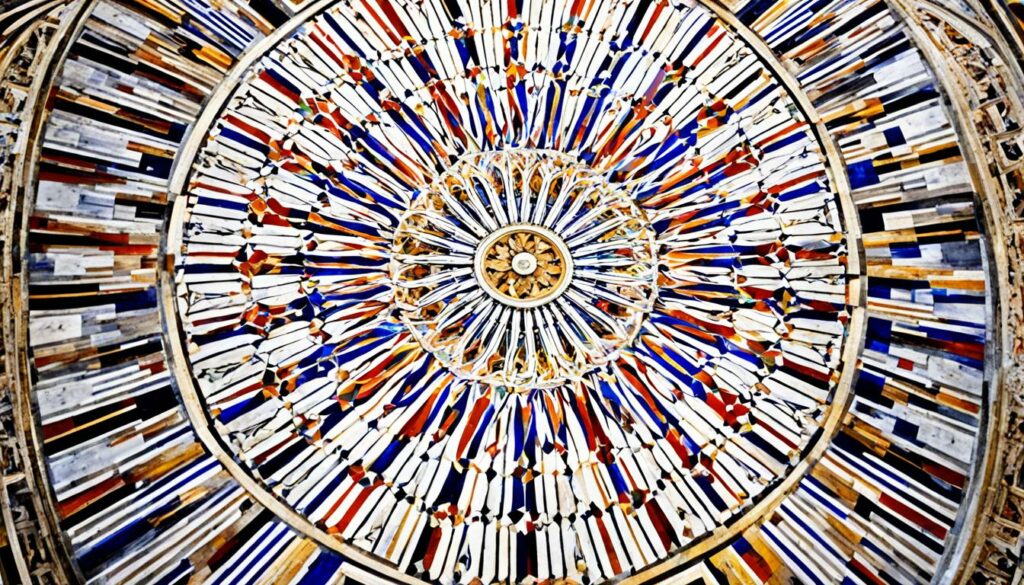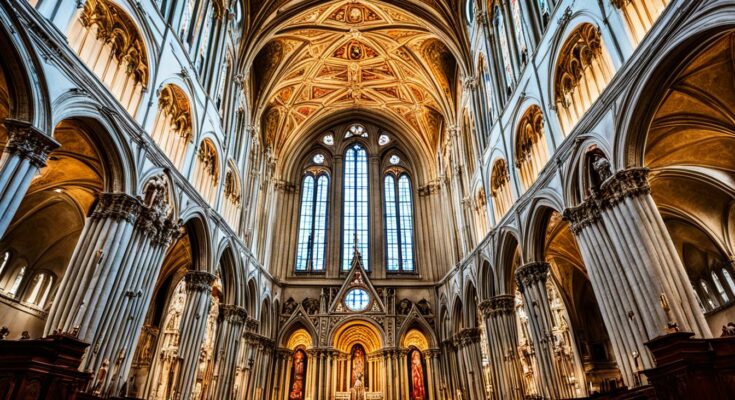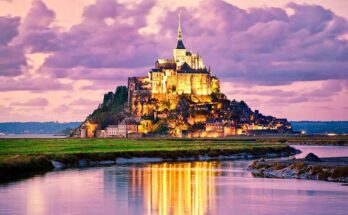Basilica di Santa Croce is a magnificent Italian basilica situated in Florence, the capital of Tuscany. This iconic landmark has a long and captivating history that spans over centuries, steeped in rich cultural and historical significance.
Throughout its history, Basilica di Santa Croce has served as a place of religious worship, a final resting place for notable figures, and a symbol of Italian identity.
In this section, we will delve deep into the history of Basilica di Santa Croce. We will explore the origins of this magnificent structure, notable figures and memorials, architectural marvels, and much more.
Key Takeaways:
- Basilica di Santa Croce is situated in Florence, the capital of Tuscany.
- The basilica has a long and captivating history, steeped in rich cultural and historical significance.
- Throughout its history, the basilica has served as a place of religious worship and a final resting place for notable figures.
- The architecture of this Gothic structure is a marvel, with intricate details in both the interior and exterior facades.
- Notable events have taken place within the walls of Basilica di Santa Croce throughout its history, from religious ceremonies to cultural celebrations.
The Origins of Basilica di Santa Croce
Discover the rich history behind one of Florence’s most iconic landmarks – the Basilica di Santa Croce. Founded in the 13th century, this magnificent Gothic structure stands tall as a testament to the artistry and vision of its creators.
The Santa Croce Basilica was built to honor Saint Francis of Assisi, and its early history is closely tied to the Franciscan order. Over the centuries, the basilica became a hub of artistic and cultural activity in Florence, drawing luminaries such as Michelangelo and Galileo into its hallowed halls.
Architecturally, Basilica di Santa Croce incorporates both Gothic and Romanesque influences, creating a unique and captivating aesthetic. Its imposing facade features a large rose window and embossed images of saints, while its interior is adorned with intricate frescoes, sculptures, and ornate chapels.
Visitors to Basilica di Santa Croce will be captivated by its stunning beauty and rich history. From its origins as a humble place of worship to its lofty status as a symbol of Italian art and culture, this basilica has truly stood the test of time.
Notable Figures and Memorials
Exploring Santa Croce Church history reveals the many prominent Italian figures who found their final resting place within the basilica’s illustrious walls. These individuals left their mark on both Italian history and culture. Some notable figures include:
| Name | Occupation | Memorial |
|---|---|---|
| Michelangelo | Painter, sculptor, architect | Creation of Adam fresco in the Bardi Chapel |
| Dante Alighieri | Writer, poet, philosopher | Marble bust in the Poets’ Corner |
| Galileo Galilei | Astronomer, physicist, mathematician | Bust in the Medici Chapel |
Other notable figures buried in Santa Croce include Niccolò Machiavelli, Gioachino Rossini, and Leon Battista Alberti, among others. These individuals are remembered through the many memorials and tributes found throughout the basilica, including frescoes, sculptures, and inscriptions in their honor.
The Historical Significance of Santa Croce Basilica
Located in the heart of Florence, Basilica di Santa Croce has played a vital role in Italian culture and identity for centuries. With its intricate Gothic architecture and richly adorned interiors, it stands as a testament to the beauty and craftsmanship of Renaissance Italy.
The historical significance of Santa Croce Basilica cannot be overstated, as it served as a gathering place for many notable historic events. During the Renaissance, Santa Croce was a favorite site of the Medici family, who funded much of the basilica’s construction and decoration. Many of history’s most famous artisans are also entombed within the walls of the basilica, making Santa Croce a haven for art lovers and historians alike.
Perhaps most notably, Santa Croce Basilica served as the backdrop for the famous “Oath of the Knights” speech delivered by Giuseppe Garibaldi in 1860, a powerful moment in Italian unification history. The speech is inscribed on a plaque outside the entrance to the basilica, a testament to Santa Croce’s continued significance in modern Italy.
The Role of Santa Croce Basilica in Italian Culture
Throughout its history, Santa Croce Basilica has been a hub of cultural and religious activity. The basilica remains a place of worship and pilgrimage for Catholics around the world, and its many chapels and shrines are filled with relics and other religious art treasures.
However, beyond its religious significance, Santa Croce has also become an emblem of Italian identity and pride. The basilica’s architecture and artworks represent the best of Italian Renaissance art, and many of the country’s most beloved figures are interred within its walls.
“Santa Croce is the soul of Florence, the true city of Florence.” – Mark Twain
Exploring the Impact of Santa Croce Basilica on Italian History
The impact of Santa Croce Basilica on Italian history is difficult to overstate. As a gathering place for major historic events and home to legendary artists and politicians, the basilica remains a crucial site for historians and cultural enthusiasts alike.
A visit to Santa Croce offers a unique opportunity to explore the roots of Italian culture and identity, from the religious traditions that have shaped the country’s history to the extraordinary feats of art and engineering that have left their mark on the world.
Architectural Marvels of Basilica di Santa Croce
One cannot help but marvel at the majestic architecture of Basilica di Santa Croce. This breathtaking landmark boasts stunning facades and intricate details, which make it a true masterpiece of Gothic style. The basilica’s exterior features an impressive rose window, intricate spires, and elaborate columns adorned with exquisite sculptures.
Step inside, and you’ll be transported to a world of wonder and splendor. The interior of the basilica is just as magnificent as its exterior, full of stunning frescoes, impressive tombs, and intricate carvings. The nave is an awe-inspiring expanse of soaring arches and delicate curves, with an intricately carved pulpit located in the center.
The chapels located within the basilica are equally impressive, with each one displaying unique architectural features and impressive artworks. One such chapel is the Pazzi Chapel, which boasts a stunning combination of Gothic and Renaissance styles and is adorned with intricate carvings and richly colored frescoes. The Bardi Chapel, on the other hand, is a beautiful example of the Early Renaissance style, with exquisite sculptures and frescoes adorning its walls.
Notable Architectural Features
| Feature | Description |
|---|---|
| The Nave | A grand expanse of soaring arches and delicate curves, topped with a stunning ceiling adorned with frescoes. |
| The Pulpit | An intricately carved masterpiece located at the center of the nave, featuring scenes from the life of St. Francis. |
| The Rose Window | A magnificent stained-glass window located on the basilica’s facade, featuring delicate tracery and vibrant colors. |
| The Bardi Chapel | A stunning example of Early Renaissance style, adorned with exquisite sculptures and frescoes. |
Basilica di Santa Croce is truly a testament to the skill and craftsmanship of the Gothic and Renaissance eras, and a must-see for anyone visiting Florence.
Notable Events in Santa Croce Basilica History
The history of Santa Croce Basilica is rich with a plethora of notable events throughout its existence. From the significant religious rituals to the cultural celebrations that have taken place within its walls, Santa Croce has stood witness to a plethora of memorable moments.
The Coronation of King Umberto I
In 1878, King Umberto I was crowned in a grand ceremony held at the Santa Croce Basilica, amidst much pomp and pageantry. The occasion marked a significant moment in the history of Italy, and the Basilica played a crucial role in underlining the country’s cultural and national identity.
The Funeral of Michelangelo
Michelangelo Buonarroti, the legendary Italian artist, sculptor, and poet, passed away in 1564. His funeral was held at the Santa Croce Basilica, where he was also laid to rest amidst much fanfare and homage.
The Florence Flood of 1966
The devastating Florence Flood in 1966 was one of the most significant natural disasters in Italy’s recent history. However, among the immense damage and destruction, the Santa Croce Basilica stood firm against the raging waters, protecting many priceless works of art and cultural treasures it contained.
The Visit of Pope John Paul II
In 1986, Pope John Paul II visited the Santa Croce Basilica, becoming the first Pope to visit the Basilica since 1557. The visit contributed to consolidating the Basilica’s position as a pivotal spiritual and cultural center in Italy and strengthened the connection between the Catholic Church and the country’s cultural heritage.
Undoubtedly, the Santa Croce Basilica has preserved an extensive record of its notable events throughout its history. These events are a testament to the Basilica’s religious, cultural, and historical significance. It remains a significant part of Italy’s rich heritage and draws captivating stories of its past that continue to enchant visitors to date.
Fascinating Facts about Basilica di Santa Croce
While Basilica di Santa Croce is widely recognized as a significant historical landmark, there are many lesser-known facts and intriguing details that make it even more fascinating.
The Artistic Treasures of Santa Croce Basilica
Basilica di Santa Croce houses a stunning collection of artworks that not only reflect the rich history of the basilica itself but also showcase the talents of many Italian masters. The walls of the chapels in the sacristy hold paintings from the 16th century by the likes of Agnolo Bronzino and Taddeo Gaddi. Moreover, the Cappella Maggiore boasts of the famous frescoes by maverick artist Giotto di Bondone painted between 1315 and 1320. The impressive detail, color, and realism lend the frescoes a unique charm that still enchants Santiago today.

“The frescoes of Basilica di Santa Croce are one of the best-preserved Gothic examples in the world,” says Luca de Luca, an art historian who has written extensively on Italian art.
Hidden Symbols and Meanings
Amidst the ornate carvings, intricate mosaics, and stunning frescoes, lies a layer of hidden symbols and meanings that is often missed by visitors. For instance, the lamb holding the banner, a recurring theme in the art pieces, represents Christ as the conquering hero. The peacock, a symbol of paradise, signifies eternal life. Similarly, the various floral motifs carry their own symbolic significance that adds to the charm and mystery of the basilica.
Burying Place of Niccolò Machiavelli
Basilica di Santa Croce houses the tomb of the celebrated Renaissance philosopher, Niccolò Machiavelli. The tomb bears an epitaph, which shows that he was buried there in 1527. It is interesting to note that this brilliant thinker was exiled from his hometown, Florence, after he fell from grace during the reign of the powerful Medici family. Though he was later pardoned, he remained largely unrecognized during his lifetime. After his death, it was only Santa Croce Basilica that paid a befitting tribute to his genius.
The Sistine Chapel Connection
The magnificent Sistine Chapel in the Vatican is one of the most famous frescoed chapels in the world, but not many know that some of the works were initially meant for Santa Croce Basilica. In the early 16th century, the Florence government paid Michelangelo, the then-rising star in the world of art, to paint frescoes to hang on the walls of the Vespucci family chapel. The project never took off, and Michelangelo later moved to Rome to work on a project under Pope Julius II. Nevertheless, the sketches he made during his stay in Florence eventually landed him the commission to paint the famed Sistine Chapel.
Conclusion
In conclusion, Basilica di Santa Croce is an irrefutable symbol of Italian culture and heritage. Its history spans centuries, from its inception as a place of worship in the 13th century to its current status as a cherished monument. This iconic basilica has witnessed the lives of notable figures and hosted significant events that have shaped Italian history.
The architecture of Basilica di Santa Croce is a marvel, showcasing stunning Gothic style and impeccable craftsmanship. From the intricate details of the interior to the striking facades, this basilica is a true work of art.
Overall, the historical significance of Santa Croce Basilica cannot be overstated. Its legacy lives on as a testament to Italian culture, and its contributions to the Renaissance and the Medici family are undeniable. With its fascinating facts and hidden treasures, Basilica di Santa Croce is a cultural treasure trove waiting to be explored and appreciated.
So, if you ever find yourself in Florence, make sure to visit this remarkable basilica and witness firsthand the splendor of its rich history.
FAQ
What is the history of Basilica di Santa Croce?
Basilica di Santa Croce has a rich history that dates back to its foundation in the 13th century. It has witnessed significant events and played a crucial role in Italian culture and identity.
How did Basilica di Santa Croce originate?
Basilica di Santa Croce was founded in the 13th century and showcases remarkable Gothic architecture. It was inspired by various architectural influences, resulting in its magnificent structure.
Who are some notable figures memorialized in Santa Croce Basilica?
Santa Croce Basilica is the final resting place for numerous prominent individuals, including Michelangelo, Galileo Galilei, and Niccolò Machiavelli. Their memorials and tributes add to the cultural significance of the basilica.
What is the historical significance of Santa Croce Basilica?
Santa Croce Basilica holds great historical significance, with ties to the Renaissance and the influential Medici family. It played a role in shaping Italian culture and identity, reflecting historical events over the centuries.
What are some architectural marvels of Basilica di Santa Croce?
Basilica di Santa Croce boasts breathtaking architectural features, from its intricate facades to the captivating details within. The Gothic style and exceptional craftsmanship exhibited in the basilica are truly awe-inspiring.
What notable events have occurred in Santa Croce Basilica’s history?
Santa Croce Basilica has hosted various notable events throughout history, including religious ceremonies, cultural celebrations, and commemorations. These events have played a part in shaping the basilica’s enduring legacy.
What are some fascinating facts about Basilica di Santa Croce?
Basilica di Santa Croce holds many intriguing secrets, such as hidden symbols and remarkable artworks. Exploring these lesser-known facts uncovers the hidden treasures that lie within this remarkable architectural gem.




